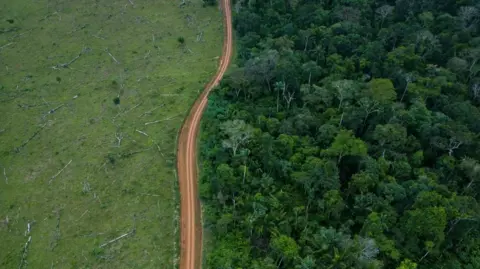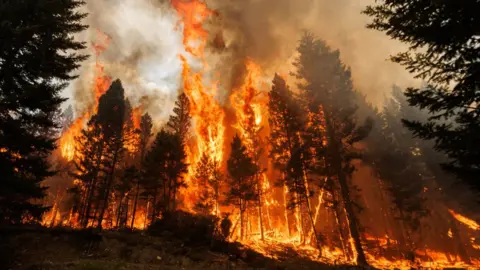Climate change: Logging decline after political change in Brazil, Colombia
 Bloomberg via Getty Images
Bloomberg via Getty ImagesThe number of trees lost in tropical forests in Brazil and Colombia fell dramatically last year because of political action, a new analysis finds.
Researchers say new leaders have prioritised the environment, with tree losses in the Brazilian Amazon down by a huge 39%.
However, increased tree felling and fires in Bolivia, Laos and Nicaragua wiped out many of these gains.
Global losses were up by a quarter, mainly due to forest fires in Canada.
The intense, long-lasting wildfires that burned across Canada drove five times more tree losses in 2023 than in the previous year.
Fires in northern forest areas have a huge impact on the overall global picture of tree cover loss, according to analysts from the University of Maryland's GLAD lab and the World Resources Institute (WRI) who publish annual data on forest felling.
But for these researchers, the intentional clearing of mature rainforests in the tropical regions is the most important measure when it comes to climate change.
In locations like the Amazon, these primary forests store vast amounts of carbon critical to the world's efforts to limit the rise in global temperatures.
These tropical regions have also been the main focus for human-driven deforestation over the past five decades.
 Getty Images
Getty ImagesIn 2023, the tropics saw 3.7 million hectares of forest lost - equivalent to 10 football fields per minute, a slight decline on last year.
These losses would have been far higher if it wasn't for Brazil and Colombia.
According to this new analysis, political action in both countries has had a significant impact on tree felling.
President Luiz Inacio Lula da Silva came to power in Brazil last year promising to tackle tree losses and end deforestation by 2030.
As a result, there has been a 36% drop in primary forest losses in Brazil in 2023, compared to 2022.
"I think what we're seeing in Brazil, for example, is really a case of putting law enforcement back in place that was dismantled during the previous government," said Rod Taylor from WRI.
Given that Brazil was responsible for 43% of all tropical forest loss in 2022, this reduction is significant.
While the drop has been welcomed, observers say that tree losses still remain higher than they were in the early 2010s.
Not all the forested regions of Brazil saw reductions. In the Cerrado, which is the centre of agricultural production, there was a 6% increase in tree loss.
 Getty Images
Getty ImagesColombia also saw a significant decline with primary forest loss down by almost half compared to 2022.
Observers say the actions of President Gustavo Petro Urrego have played an important role in the fall.
"The story of deforestation in Colombia is complex and deeply intertwined with the country's politics, which makes 2023's historic decrease particularly powerful," said Alejandra Laina, from WRI, Colombia.
"There is no doubt that recent government action and the commitment of the communities has had a profound impact on Colombia's forests, and we encourage those involved in current peace talks to use this data as a springboard to accelerate further progress."
But elsewhere the picture on tree loss remains poor.
Bolivia saw a record loss for the third year in a row with numbers up 27% on 2022. Around half of this was down to fires, as hot weather saw fires started by humans spread into forests.
There were also notable upticks in Laos and Nicaragua, mainly due to agricultural expansion.
 Getty Images
Getty ImagesIndonesia also saw an increase in losses, but the rate remains historically low compared to a decade ago.
Researchers say the overall picture is decidedly mixed, and they point to the fact that the world has just six years left to keep a promise to halt deforestation, made in 2021 at COP26 in Glasgow.
"This report appropriately challenges us to balance despair and hope at the same time," said Dr. Andrew Steer, president and CEO of the Bezos Earth Fund.
"The alarmingly high rates of global deforestation remind us how badly off track we are in solving the climate and nature crises."
